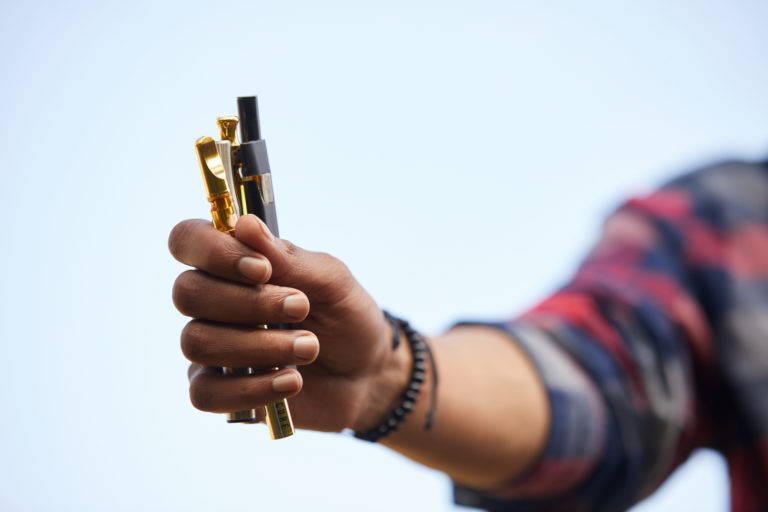Cannabis vaporization has exploded in popularity in recent years. Vaporization, or vaping, uses vapor to disseminate cannabinoids into the bloodstream. There is a wide range of vaping devices available to meet the needs of different users, and it's recognized as an easy and discreet method of consuming cannabis.
 Photo by: Gina Coleman/Weedmaps
Photo by: Gina Coleman/WeedmapsImage lightbox

Although vaping cannabis only became common in the past several years, the practice has been around for much longer. The first electronic cigarette patent was filed in 1963. The invention wasn't mass-produced, but four decades later, pharmacist Hon Lik patented the vape pen and vaping took off. By 2014, global sales of vaping devices were worth just under $5 billion. In 2018 the global market had doubled to $11.5 billion, according to a forecast by market research company iMarc.
A 2019 outbreak of lung disease linked to vaping has recently thrown the belief that vaping is a safe alternative to smoking into question. Research into vaping is helping us to understand what contributed to this crisis, and whether vaping still represents a safe method of cannabis consumption or not.
What do you vape?
Vaping devices such as e-cigarettes, vape pens, and mods can be filled with a variety of cannabis extracts or concentrates in many forms. The most common is distillate, a highly refined oil containing only a few cannabinoids such as THC or CBD. Specialty concentrates, like CO2 oil, shatter, and full-spectrum extracts, contain diverse cannabinoids and provoke a different experience.
Does vaping get you higher than smoking?
While it's recognized that everybody processes cannabis and cannabinoids a little differently, people often debate whether vaping gets you higher than smoking.
A study published by the JAMA Open Network in November 2018 found that people who had been vaping weed had higher quantities of THC in their bloodstream than those who had been smoking weed.
The study, which was posted on Reddit, elicited hundreds of comments. While the responses varied, most concurred that vaping marijuana flower gets you higher than smoking it. According to the study, vaporizers may offer a more efficient delivery method. There is no loss of THC as a result of combustion or sidestream smoke--one of the inconvenient side effects of smoking THC oil (also known as cannabis oil or hash oil).
The benefits of vaping cannabis
Vaping has been thought to be a healthier mode of administration than smoking because studies have shown that the combustion of plant material introduces airborne and skin-borne carcinogens into the body.
 Photo by: Gina Coleman/Weedmaps
Photo by: Gina Coleman/WeedmapsImage lightbox

Vaping heats cannabis flower, extract, or concentrate to a certain point which releases the cannabinoids and terpenes without igniting the plant material or creating smoke. Since the cannabis flower or concentrate is heated at a lower temperature and no smoke is involved, many argue that fewer cannabinoids are destroyed.
The risks of vaping cannabis
However, vape concentrates and cartridges sometimes include thinning agents or other additives. When heated, these can break down into compounds such as formaldehyde, which are carcinogenic.
According to the CDD, in August 2019, hundreds of cases of lung disease arose which were later linked to vaping. By the end of 2019, the Centers for Disease Control and Prevention (CDC) had reported at least 55 deaths and more than 2,500 hospitalizations due to lung injuries in all 50 states. By February 18, 2020, the number of deaths had increased to 68 and hospitalizations to 2,807. The disease has since been referred to as EVALI, and is strongly correlated with THC vape cartridges found on the illicit market.
The CDC has released findings based on hospital admissions and laboratory data that suggest that vitamin E acetate has played a role in the EVALI outbreak. Vitamin E acetate is often used to dilute or thicken THC oil because it's colorless, odorless, has a similar viscosity to THC oil, and is much cheaper. Referred to as a cutting agent, it can be used to stretch the amount of THC oil in vape pens.
According to a study published in the December 2019 New England Journal of Medicine, vitamin E acetate was identified in fluid obtained from 48 of 51 patients in 16 states but was not present in such fluid obtained from healthy patients. Further data from Utah has found vitamin E acetate present in 89 percent of the vape cartridges collected from patients with symptoms of EVALI.
The authors of The New England Journal of Medicine study theorized that vitamin E acetate may contribute to lung injury by creating ketene when heated. Ketene is a reactive compound that has the potential to be a lung irritant, depending on its concentration.
The aspiration of vitamin-E acetate may also lead to lipoid pneumonia, an inflammatory response that occurs after someone inhales a fat or oil. However, correspondence published in the October 2019 New England Journal of Medicine reported that lipoid pneumonia was not evident in lung tissue taken from patients with vaping-associated lung injury. The samples taken showed no evidence of lipoid pneumonia. While lipoid pneumonia can't be discounted, the samples suggested a form of airway-centered chemical pneumonitis caused by the inhalation of toxic substances. There may be additional chemicals or ingredients involved in the EVALI outbreak that are yet to be identified.
Are dab pens bad for you?
The degradation of cannabis concentrates used in dabbing was the subject of a 2017 Portland State University (PSU) study. Researchers found that vaping with dab pens “may deliver significant amounts of toxic degradation products when consumed at high temperatures.”
The authors also indicated that the addition of terpenes as flavorings was also a concern. Terpenes are volatile and prone to oxidation when heated. There is currently little research about what happens to the chemical structure of terpene additives at high temperatures.
What to do if you feel sick
Clinicians are now urged to report possible cases of EVALI to their local or state health departments. Scientists, researchers, and industry experts alike are currently seeking evidence-based harm reduction solutions. These measures include educating consumers about avoiding illicit vaping devices and promoting awareness of how to detect counterfeit vape cartridges.
Further research into the safety of cutting agents used for dilution and additives is ongoing. There is already evidence that overheating other cutting agents, such as polyethylene glycol, may produce harmful, carcinogenic compounds. Products such as cannabis distillate and raw flower do not contain additives.
According to the CDC, the safest way for people to ensure that they are not at risk while the investigation continues is to consider refraining from the use of all vaping products. Those who won't consider refraining from vaping are urged to avoid e-cigarettes bought on the illicit market and use branded e-cigarette products that haven't been modified.

